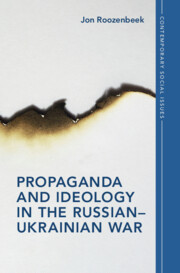Book contents
- Propaganda and Ideology in the Russian–Ukrainian War
- Contemporary Social Issues Series
- Propaganda and Ideology in the Russian–Ukrainian War
- Copyright page
- Contents
- Figures
- Maps
- Tables
- Acknowledgements
- Note on Transliteration
- Abbreviations
- Maps
- Introduction
- 1 A History of Russian–Ukrainian Relations
- 2 The Politics of the Donbas ‘Republics’
- 3 Building a Propaganda Machine
- 4 Newspaper Narratives in Occupied Ukraine
- 5 Identity and Ideology in Online Media
- 6 The Consequences of Propaganda
- Concluding Remarks
- Appendices
- References
- Index
4 - Newspaper Narratives in Occupied Ukraine
Published online by Cambridge University Press: 16 May 2024
- Propaganda and Ideology in the Russian–Ukrainian War
- Contemporary Social Issues Series
- Propaganda and Ideology in the Russian–Ukrainian War
- Copyright page
- Contents
- Figures
- Maps
- Tables
- Acknowledgements
- Note on Transliteration
- Abbreviations
- Maps
- Introduction
- 1 A History of Russian–Ukrainian Relations
- 2 The Politics of the Donbas ‘Republics’
- 3 Building a Propaganda Machine
- 4 Newspaper Narratives in Occupied Ukraine
- 5 Identity and Ideology in Online Media
- 6 The Consequences of Propaganda
- Concluding Remarks
- Appendices
- References
- Index
Summary
This chapter examines newspaper discourse in the Donetsk and Luhansk ‘People’s Republics’, analysing the content of twenty-six local newspapers between the start of the Euromaidan demonstrations in late 2013 and the end of 2017. The goal of this chapter is to uncover the themes and narratives in DNR and LNR print media, and examine how these narratives relate back to ideology and identity building. Three main narratives are identified: ‘business as usual’, ‘war and memory’, and ‘loss and guilt’. Newspapers in the Donbas ‘Republics’ continued to perform ‘typical’ activities as a source of information for local communities. However, a significant part of their content did address the development of collective identity, for example, through references to newly instated public holidays and a kinship with Russia and the Russian language. However, this ‘ingroup’ identity remained impoverished, projecting an identity discourse without a sui generis, unifying coherence. Instead, negative descriptions of the ‘outgroup’ (i.e., Ukraine/the ‘Kyiv regime’) received much more attention, with a view to demonising Ukraine and Ukrainians in the eyes of the local population.
- Type
- Chapter
- Information
- Propaganda and Ideology in the Russian–Ukrainian War , pp. 65 - 82Publisher: Cambridge University PressPrint publication year: 2024

